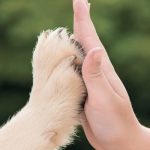It may seem an odd and few medical argument, instead it has got an extreme importance: the faeces that each animal produces allow us to notice many things. Let us consider all their aspects:
- The frequency:
it changes a lot according to the characteristics of each four legged friend For the cat, for example, it can be absolutely normal deposit the faeces even once every 2 days, but if more days pass, we could talk about constipation. In this case, they will be very hard, dry and will cause pain during emission maybe with very high cries. On the contrary, frequent evacuations that keep consistence, shape and color can be normal in the dog, who deposit them each time he goes out for a walk. - The color:
it changes according to the food: white meat or fish will give a paler color than red meat. I remind that they don’t have to be white or pearly because this color indicated serious gastric problems linked to the lack or an insufficient production of bile acids that normally color the faeces. On the contrary, black excrements could be the symptom of gastric or duodenal bleedings. The presence of vegetable of other components in the food can show themselves in the faeces with green pieces or orange pieces caused by carrots, but also by objects swallowed for fun as plastics, woods or small stones. - Shape:
Both in the cat and in the dog, the shape has to be cylindrical: more linear in the dog, with smaller pieces in the cat. In case you notice a more squeezed shape (like a ribbon) and a difficulty during evacuation in male old enough dogs, we might consider the presence of a pathology similar to the one of man called “Benign Prostate Hyperplasia”. In the cat, instead, this disturb can’t verify because he doesn’t have this gland. The shape can sometimes change during emission: from normal it can be mushy, maybe with traces of blood. - Dimension:
it changes with alimentation very much. The dry food tends to produce voluminous faeces, in difference with the wet one both industrial that made at home. - Solidity:
also this parameter changes very much. If the subject is healthy, the faeces will have a solid compactness and could be easily collectable (detail that many owners tell me). The soft, mushy ones are instead always indication of an intestinal problem. In this case according to the presence of mucus, blood or lot of liquid, we can start to make a differential diagnosis of disease of duoden or colitis, which is important to start the correct therapy. - Odor:
well, this particular is important as well. The faeces must stink: the lack of odor or the presence of acidity, fermentation or rot can give the Veterinary a good suggestion for possible running pathologies. - The collection:
always collect the faeces of your pets. Besides of being a civil act, it prevent the appearance of parasites, an argument I will deal with in a next text:

The cat toilet Sabbia with elegant rattan design.
The Bama Pet products also think about this demand of your four legged friends with 2 products: the cat toilet Sabbia, equipped with bag clips easily removable to allow to change the santiary bag and the cat toilet Privè, for the most demanding and discreet kitties.











